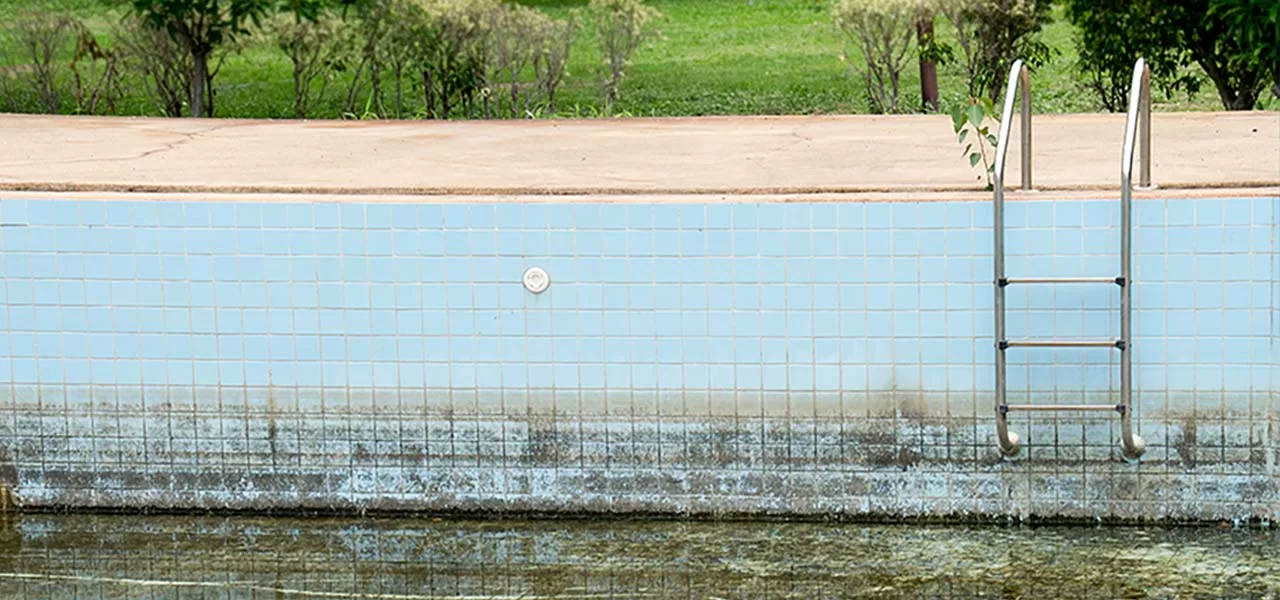FREE Standard Shipping On All Orders $100 or More!*

Opening a Pool Neglected for YEARS
Pools that are unattended, without chemicals, circulation and cleaning, don't last long. Within weeks, they become green, and within months, they become home to frogs and mosquitoes. If left for too long, pool surfaces begin to deteriorate. So how do you handle opening a neglected pool?
We're glad you asked! Today we'll discuss the best practices for opening and taking care of a neglected pool.
To Drain or Not to Drain?

For gunite pools, the decision may be easier. The pool probably should be drained and acid washed, for best results. For vinyl and fiberglass pools, draining the pool completely has an element of risk. Vinyl liners can relax with the water removed, and if the liner is old, it may shrink and snap when drained. Fiberglass pools are relatively lightweight, and water removal can cause the shell to pop out of the ground, or shift slightly.
Restoring neglected poor water can be a long process, with possibly hundreds of dollars spent on pool chemicals before any headway is gained. And even though it eventually clears, it will contain the dead organic matter and the cellular memory of the swamp it once was, making it more difficult to avoid future algae problems.
Another reason for draining the pool is to remove stains. Acid washing restores the finish by stripping away a tiny layer of plaster, exposing the fresh plaster underneath. You may also decide to drain the pool to also make repairs to the plaster or fiberglass, or to replace the pool liner.
Drain the Pool

For pools that are very neglected and with lots of debris, a trash pump would be the best choice. This can be rented for the day, along with a suction and discharge hose, and will drain a pool in under an hour. It can also suck up leaves, twigs, and solids the size of a golf ball, which means no dredging that muck out of the pool!
If the pool is fairly clean, without large debris, a smaller gas pump or a submersible pump can also be used.
To prevent floating the pool, or having an empty pool pop out of the ground, follow these guidelines:
- Assess the topography. Is the pool on a hillside, or down in a valley?
- Avoid draining during or immediately after wet periods of heavy rain.
- Pump discharge water far away and downhill from the pool or into a storm drain.
- When water reaches the floor, open the hydrostatic plugs in the floor (plaster pools only).
- Work fast and refill the pool as soon as possible.
After draining, the pool can be pressure washed or acid washed (plaster pools only). Vinyl and fiberglass can be cleaned with a mild soap and low-pressure washing.
Don't Drain the Pool

For those of you who are dead set against draining the pool, here are some alternatives to draining the pool. Keep in mind it will take a lot of time and effort to clean and sanitize a neglected, green pool.
- Clean the pool using leaf nets and leaf baggers, to remove 99% of the organic debris. Even if you can't see the bottom, work the floor until your nets come up clean. This is an important step, so don't skimp here. Continue to skim and brush the pool daily during treatment.
- Balance the pool water. pH, Total Alkalinity, Calcium Hardness, and stabilizer will likely all need to be heavily adjusted. Check and readjust daily during the treatment process.
- Shock the pool until the water turns a blue-gray color. If it turns back to a light green color, hit it again. You'll need lots of pool shock to reach at least 30 parts per million (ppm). Prepare to use 5–10 pounds per 10,000 gallons of pool water.
- Run the filter 24/7 until the water clears, and resist the urge to clean the filter until the pressure gauge is 5–10 lbs higher. Use a filter cleaner, or change the sand or cartridge once the pressure gauge rises.
- Use a clarifier to help coagulate suspended particles, or use flocculant to drop particles to the bottom of the pool.
- Fill the pool high with water and vacuum the pool to waste, by setting the multiport filter valve to waste.
Fill the Pool
For those with a water well on the property, filling an inground pool from the hose brings worry about "burning the pump up" or running the well dry. In most cases, a pool can be filled from the well, but it can be a slow process.
Trucked in pool water is an option in most areas. It can be expensive, however. Depending on where you live, filling a pool from a truck (via a fire hydrant), can cost $1,000 or more. A less expensive option may be to fill the pool halfway from a truck, and the rest from the well, or start it from the well, and if needed, finish it from the truck.